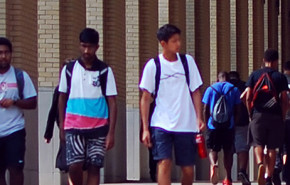As Higher Education continues to transform, what are colleges doing to keep students on campus?
Green lawns, red brick buildings, packed libraries full of students pulling all-nighters, and Animal House style frat parties have all been a part of the traditional college experience for nearly half a century, and is ingrained in our minds as the typical life for many students. However, higher education is transforming drastically and the customary college experience is evolving with it. This has presented a challenge to brick-and-mortar colleges—they want to find ways to keep students on their campuses and in their classrooms.
Due to tuition hikes and student debt that now exceeds credit card debt, many students are seeking more cost-effective alternatives to higher education. A recent Brookings Institute article highlights the changes occurring in higher education, including the popularity of online courses, Massive Open Online Courses (MOOCs), and less pricey upstart colleges. These options are attracting students who want to save time and money while earning degrees. For example, Western Governors University, a national non-profit online university, gives students who already have some college experience the opportunity to complete their degrees with programs that let them study at their own pace and on their own schedules—and at a cheaper price. Melissa Clark, WGU’s Project Manager for General Education Program Development, says they’ve seen a huge rise in numbers.
“Based on our growing reputation and word of mouth success from our students, WGU enrollment has grown to over 60,000 students in 2015, more than doubling in size over the past five years,” says Clark.
Nevertheless, students who still crave the traditional sense of a college community and in-person learning will be headed back to conventional campus environments this fall. So, what are the traditional four-year colleges and community colleges doing to set themselves apart from the competition and retain and attract new students? Many colleges are turning to consultants such as GAI for a new focus on campus planning and design—a fresh appearance and appealing new learning environments. Such updates include: new student common areas, fitness centers, sports arenas, modern dining options, new student unions, updated dormitories, green infrastructure, and welcoming spaces for community life on campus.
One such institution is Valencia College in Orlando, Florida, nationally recognized as one of the best 2-year colleges in the nation for its high graduation and placement rates. In 2011, Valencia won the first Aspen Prize for Community College Excellence. GAI was integral in the construction of Valencia’s new Allied Health and Sciences Building, which obtained a Silver LEED certification and is the first LEED certified building on campus. A pristine 36-foot tall oak tree that was situated in the center of the building’s parking lot area was incorporated into GAI’s design. Alan Bottorff, the VP of Facilities and Planning at Valencia, believes that a campus and its facilities have a great impact on the student experience, including how the architecture flows with its environmental surroundings.
“I think an outdoor space is as important as the indoor space,” says Alan. “Ideally, I would love for a student to not even recognize that they’re in a different place than their home.”
GAI has assisted multiple colleges in their efforts to improve their campuses and facilities. When West Virginia State University updated their campus with a new convocation center and basketball arena, GAI provided complete site design services, including civil engineering and landscape architecture. Carnegie Mellon University, located in Pittsburgh’s Oakland community—which has the highest concentration of academic and medical institutions in Pennsylvania—retained GAI to support their efforts to provide safer transportation access for pedestrians, bikers, motorists, and other transit users. GAI analyzed incident data, inventoried university parking, identified campus destinations and bike/pedestrian corridors, studied pedestrian and cyclist movement, and designed concepts for street configurations that maximize safety and access for pedestrians. The University of Central Florida—the second largest university in the US—worked with GAI on a 1400-acre Campus Landscape Master Plan to complement their growth and retention strategies.
“When a student comes on your campus, that’s your first calling card. That’s your first opportunity to tell them what you’re really about.”
GAI is dedicated to working with collegiate clients and helping them advance their goal of increasing student enrollment by enhancing the campus experience. While quality of education is a significant factor to consider on those prospective student tours, GAI’s campus planning professionals know that the quality of the campus is just as important.
“When a student comes on your campus, that’s your first calling card,” says VCC’s Bottorff. “That’s your first opportunity to tell them what you’re really about.”
For more information on the impact of Higher Education trends or GAI’s services, contact Frank Bellomo, PLA, Assistant Vice President, at 407.423.8398.


